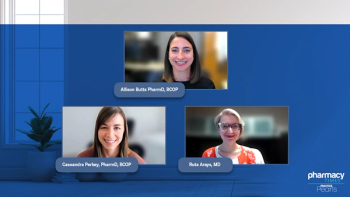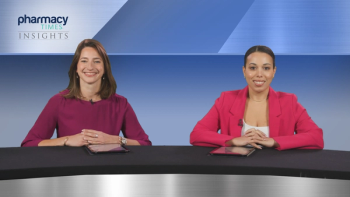
Roles Of Pharmacists In The Management Of MCL
Ryan Haumschild, PharmD, MS, MBA, enlightens the panel on the unique roles of pharmacists in treatment management for patients with mantle cell lymphoma.
Episodes in this series

Ryan Haumschild, PharmD, MS, MBA: Dr Wang, thank you for talking about the interaction of cardiology and the primary team. Cardio-oncology is becoming so important because we have to rely on team-based care. Oftentimes, we need to control cardiac abnormalities because patients are so interested in being on therapies that give them the best outcome. BTK [Bruton tyrosine kinase] inhibitors provide a great outcome with a reduced toxicity profile that a lot of patients can tolerate.
How do we accommodate cardiac history? As a pharmacist, this is something my team and I are always looking for. Is the patient on any blood thinners, aspirin, or any medication significant for cardiac history? How do we screen for this? Oftentimes, if we get a patient who’s referred in from a community oncology practice and they’re on a first-generation BTK inhibitor, is there a specific reason for that? Can we transition them to a next-generation BTK inhibitor that might provide better outcomes but also help provide lower incidence of cardiac issues for us to work through? That’s something that I’m always hyper-focused on.
When we think about some of the next-generation BTK inhibitors, I think about some of the adverse effects. I think about acalabrutinib. Is it going to be absorbed less if the patient is on a proton pump inhibitor [PPI] or an H2 blocker? What modifications can I recommend to that patient in therapy? That’s an important role that I play. I’m also always looking at whether patients are on any steroids. Is there any reason that they would be on steroids or have any type of fungal infection or be at an increased risk for fungal infection based on immunocompromised status? When I think about that, I also think about how we need to modify therapy. As a pharmacist, I focus on some of these key areas on top of education and the reviewing and monitoring [of] these patients.
When we look at pharmacists in clinical practice in the treatment of mantle cell lymphoma, it’s a smaller patient population, but I feel like these NCI [National Cancer Institute] Comprehensive Cancer Centers like ours and [The University of Texas] MD Anderson [Cancer Center] see a disproportionately higher share of these patients. It gives us a great opportunity to design optimal-based care. I focus on developing the proper order sets within our electronic medical record to make sure that we not only have the therapy built in but also some of those supportive care medications.
If a patient is started on acalabrutinib, they might be at propensity of having some type of skin rash. How do I provide them that supportive care therapy ahead of time? I counsel them on that therapy so that if a rash occurs, they’ll let us or the clinic know right away and already have that supportive care medication on hand. That means that they can intervene on that rash early. There’s a reduced time to modification of therapy.
Another thing is that if a patient has rate-limiting adverse effects, which occasionally come up, how do we build in dose reductions? Whether my providers are on inpatient service or are working for us through a collaborative practice agreement, we can dose-modify that patient rather quickly, call that in to the pharmacy, and make sure the patient knows how to take their new therapy that was reduced based on some of those rate-limiting toxicities.
It’s helpful to develop a patient-specific calendar. Nothing is more frustrating than when a patient was designed what I think is the perfect plan from my provider colleagues but isn’t taking their medication appropriately. That gives us the opportunity to come in and make sure that they can afford the medication and that they understand the contraindications when they start a new therapy, and to let us know. With any type of dose reduction, we let them know ahead of time. “This might be a part of your plan. Don’t be afraid to tell us about some of these toxicities so we can intervene early, as opposed to not telling us because you’re scared of a dose reduction.”
Finally, as we monitor these patients, we have a large internal health system-owned specialty pharmacy of oral dispensing. A lot of other NCI-designated Comprehensive Cancer Centers do it themselves. How do we create a care management plan where we’re following up with that patient prior to every fill, screening them for any abnormalities and to see if they started any new therapies? And if they have any complaints, that we can raise them up to the clinic team so we can provide that intervention and good communication and document that within the electronic medical record.
Dr Jain and Dr Wang, both of you have extensive practice and are leading researchers and providers in the field of mantle cell lymphoma. But I also know you’re big fans of team-based care, and you defer to others’ expertise and get a lot of people involved in the treatment of your patients. But when we specifically think about pharmacists in your institution, how are they involved in that patient care journey? How much do they get involved working with you and the patient throughout that continuum of care?
Preetesh Jain, MBBS, MD, DM, PhD: Absolutely. It’s totally team-based patient care. There aren’t any barriers to discussion with other teams. It’s very important. That’s one thing that I learned from Dr Wang, where we have so many collaborations with cardiologists, nuclear medicine doctors, gastroenterologists, pathologists—everybody. The pharmacist’s role is pivotal in this. Whenever we design any trial, write any protocol, or think of prescribing any medication, when they’re sitting in the same room, we discuss it with them. These patients are generally older and are already receiving some of these other agents that might have a propensity to influence the metabolism of these agents that we’re going to prescribe.
There’s an ongoing discussion with respect to their cardiac medications, anticoagulants, PPIs, acid-reducing agents, and the medicine that we’re going to prescribe. Even if it’s chemotherapy, like bendamustine or rituximab, we talk to the pharmacist about interactions, antiarrhythmic propensity, the adverse effect profile, and the risk of infections with each agent and how it can influence the prescription of this particular agent. That’s a very important discussion. It can be elaborated on in the context of each agent, but that’s a broad way to answer this question.
Michael Wang, MD: We could no longer deliver good therapy without the help of pharmacists and PharmDs. In our inpatient unit, every patient discussion and decision about therapy involves the intimate collaboration with a PharmD on every patient in the hospital. When we’re practicing outside in the clinic, we have a PharmD on call all the time to answer questions. For example, if the patient has severe GERD [gastroesophageal reflux disease] and we have to stop acalabrutinib to give the patient a break of protonic therapies to control the symptoms.
Some of the drug-drug interactions are beyond our capability to handle, including FLT-3 inhibitors, and knowing how many dose reductions the drug-drug interactions require with ibrutinib or other BTK inhibitors. We need the expertise of PharmDs. Also, you know some of the upcoming interactions. For example, there are new reports that when ibrutinib and venetoclax are used together, they have each other’s…concentrations in the blood. Therefore, when they’re used together, sometimes there are potential risk factors for severe adverse effects, such as cardiac toxicities. It’s great for me and Dr Jain to be sitting in this session interacting with you, seeing the best…in action.
Ryan Haumschild, PharmD, MS, MBA: I always appreciate those comments. That’s what’s exciting about not only getting involved in the research and patient care but the future of therapies.
Transcripts edited for clarity.
Newsletter
Stay informed on drug updates, treatment guidelines, and pharmacy practice trends—subscribe to Pharmacy Times for weekly clinical insights.






















































































































































































































